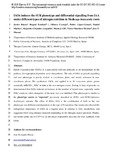IAOx induces the SUR phenotype and differential signalling from IAA under different types of nitrogen nutrition in Medicago truncatula roots
Fecha
2019Autor
Versión
Acceso abierto / Sarbide irekia
Tipo
Artículo / Artikulua
Versión
Versión aceptada / Onetsi den bertsioa
Identificador del proyecto
Impacto
|
|
10.1016/j.plantsci.2019.110176
Resumen
Indole-3-acetaldoxime (IAOx) is a particularly relevant molecule as an intermediate in the pathway for tryptophan-dependent auxin biosynthesis. The role of IAOx in growth-signalling and root phenotype is poorly studied in cruciferous plants and mostly unknown in non-cruciferous plants. We synthesized IAOx and applied it to M. truncatula plants grown axenically with NO3-, NH4+ or urea as the sole ...
[++]
Indole-3-acetaldoxime (IAOx) is a particularly relevant molecule as an intermediate in the pathway for tryptophan-dependent auxin biosynthesis. The role of IAOx in growth-signalling and root phenotype is poorly studied in cruciferous plants and mostly unknown in non-cruciferous plants. We synthesized IAOx and applied it to M. truncatula plants grown axenically with NO3-, NH4+ or urea as the sole nitrogen source. During 14 days of growth, we demonstrated that IAOx induced an increase in the number of lateral roots, especially under NH4+ nutrition, while elongation of the main root was inhibited. This phenotype is similar to the phenotype known as “superroot” previously described in SUR1- and SUR2-defective Arabidopsis mutants. The effect of IAOx, IAA or the combination of both on the root phenotype was different and dependent on the type of N-nutrition. Our results also showed the endogenous importance of IAOx in a legume plant in relation to IAA metabolism, and suggested IAOx long-distance transport depending on the nitrogen source provided. Finally, our results point out to CYP71A as the major responsible enzymes for IAA synthesis from IAOx. [--]
Materias
Ammonium,
Auxin,
Indole-3-acetaldoxime,
Nitrate,
Oximes,
Phenotype,
Superroot,
Root,
Urea,
CYP71A
Editor
Elsevier
Publicado en
Plant Science, 287 (2019) 110176
Departamento
Universidad Pública de Navarra. Departamento de Ciencias /
Nafarroako Unibertsitate Publikoa. Zientziak Saila /
Universidad Pública de Navarra/Nafarroako Unibertsitate Publikoa. Institute for Multidisciplinary Research in Applied Biology - IMAB /
Universidad Pública de Navarra/Nafarroako Unibertsitate Publikoa. Institute for Advanced Materials and Mathematics - INAMAT2
Versión del editor
Entidades Financiadoras
This work was supported by the grants AGL2017-86293-P, CGL2017-84723-P (IBERYCA) and AGL2014-52396-P, from the Spanish Ministry of Economy and Competitiveness (MINECO) and the Ministry of Science Innovation and Universities (MICINN) and by the Basque Government (IT932-16). JB and PL-G are holders of PhD fellowships from the Public University of Navarre. ACh received a Juan de la Cierva initiation grant FJCI-2016-27905 and RE received a Juan de la Cierva incorporation grant IJCI-2014-21452. This research was also supported by the Basque Government through the BERC 2018-2021 program, and by the Spanish Ministry of Science, Innovation and Universities through the BC3 María de Maeztu excellence accreditation (MDM-2017-0714).







